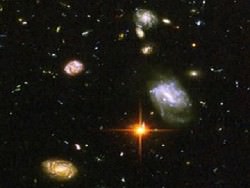We’ve talked about Venus, the hottest planet in the Solar System, but we know things can get pretty hot here on Earth, too. You may be wondering, where on the surface of the Earth has the highest natural temperature been recorded?
The location of this world record has had some controversy, but as of 2013, the hottest spot on record was the Furnace Creek Ranch in California’s Death Valley. On July 10, 1913, weather instruments measured 56.7 degrees Celsius, or 134 degrees Fahrenheit.
The previous record of 56 degrees at El Azizia, Libya was overturned because a systematic study in 2012 discovered there were errors in the measuring methods.
Similar temperatures to Death Valley’s record have been recorded around the World:
55 degrees in Africa,
53.6 in Asia,
50.7 in Australia,
and 49.1 in Argentina.
But these are just measurements from weather stations. It’s likely there are hotter temperatures, but nobody was around to measure. NASA satellites have spotted regions in Iran’s Lut desert which might have reached 70 degrees Celsius during the summers of 2004 and 2005.
So that’d be the hottest spot on the surface, but what about the hottest natural spot anywhere in the entire planet? Now you’ve got to travel straight down 6,371 kilometers to the very center of the Earth. At the inner core, the temperatures rise to about 5,430 degrees C, or 5700 Kelvin. Amazingly, this is about the same temperature as the surface of the Sun.
Some of this high temperature comes from leftover heat from the formation of the planet, 4.54 billion years ago, but the vast majority comes from the decay of radioactive minerals inside the Earth. It was likely hotter in the past, but all the short-period isotopes have already been depleted.
I keep saying the word “natural”, but what about “unnatural”? Wondering about the hottest temperature EVER generated on Earth? Thermonuclear explosions reach temperatures of tens of millions of Kelvin. Fusion experiments have hit 500 million Kelvin. But that’s nothing.
In 2012, physicists working with the Large Hadron Collider were investigating the conditions that might have existed during the earliest moments of the Big Bang.
They generated a quark gluon plasma that had a temperature of 5.5 trillion Kelvin.
Unless aliens can do better, this is not only the hottest temperature ever recorded on Earth, it’s easily the hottest temperature anywhere in the Universe since the Big Bang itself.






